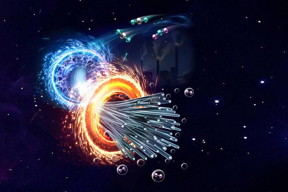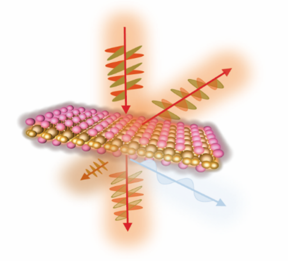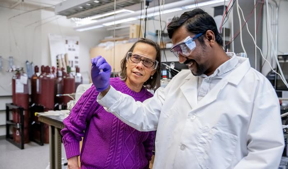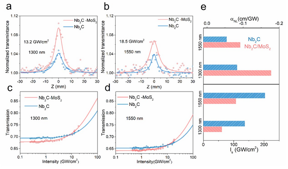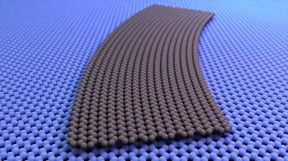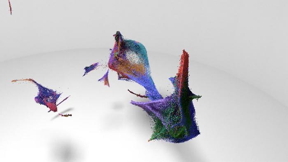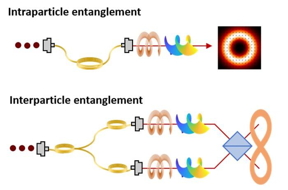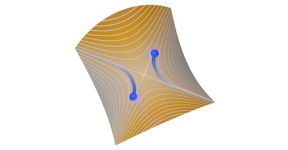Home > Press > Presenting: Ultrasound-based printing of 3D materials—potentially inside the body
 |
Abstract:
A new approach to three-dimensional (3D) printing uses ultrasound waves to create objects from sonically cured inks.
Presenting: Ultrasound-based printing of 3D materials—potentially inside the body
Washington, DC | Posted on December 8th, 2023The approach enables volumetric 3D printing even in opaque media or at deep penetration depths, including, potentially, inside the body. 3D printing technologies are poised to revolutionize manufacturing processes for a wide range of applications. Volumetric printing, an emerging 3D printing technique, can build objects faster and with better surface quality than printing methods that build objects layer-by-layer. Most existing volumetric printing techniques rely on light to trigger photopolymerization in optically transparent inks. However, light scattering by the inks themselves, the presence of functional additives within the inks, and light-blocking by already cured portions of the build limit the material choices and the build sizes feasible, particularly in configurations that require deep light penetration. Compared to light waves, ultrasound waves can penetrate much deeper into materials and can, in principle, be used to trigger polymerization. Here, Xiao Kuang and colleagues present a new approach to volumetric printing they call deep-penetrating acoustic volumetric printing (DAVP), which uses focused ultrasound waves and “sono-ink.” The sono-ink the authors developed overcomes key challenges of acoustic volumetric printing by using a thermally responsive adaptive acoustic absorber to form a viscous gel that prevents streaming flow while simultaneously initiating a heat-triggered polymerization. In tests, DVAP allowed the authors to print objects quickly from various nanocomposite materials at a millimeter scale – and several centimeters deep in opaque media. As a proof of concept, Kuang et al. applied DAVP to high-speed, high-resolution through-tissue manufacturing and minimally invasive medicine. Through experiments in ex vivo tissues infused with sono-ink, the authors demonstrate the in situ fabrication of artificial bone and of a left atrial appendage closure. In a related Perspective, Yuxing Yao and Mikhail Shapiro discuss the DAVP approach, its limitations, and its potential uses, including minimally invasive medical procedures. “It is conceivable that the running shoes of the future could be printed with the same acoustic method that repairs bones,” Yao and Shapiro write.
####
For more information, please click here
Contacts:
Media Contact
Science Press Package Team
American Association for the Advancement of Science/AAAS
Expert Contacts
Junjie Yao
Duke University
Office: 1-919-681-0691
Cell: 1-314-368-6734
Yu Shrike Zhang
Brigham and Women’s Hospital, Harvard Medical School
Office: 1-617-768-8221
Cell: 1-314-378-1967
Mikhail G. Shapiro
Howard Hughes Medical Institute, California Institute of Technology
Copyright © American Association for the Advancement of Science/AAAS
If you have a comment, please Contact us.Issuers of news releases, not 7th Wave, Inc. or Nanotechnology Now, are solely responsible for the accuracy of the content.
| Related Links |
| Related News Press |
News and information
![]() World’s first logical quantum processor: Key step toward reliable quantum computing December 8th, 2023
World’s first logical quantum processor: Key step toward reliable quantum computing December 8th, 2023
![]() VUB team develops breakthrough nanobody technology against liver inflammation December 8th, 2023
VUB team develops breakthrough nanobody technology against liver inflammation December 8th, 2023
![]() Finding the most heat-resistant substances ever made: UVA Engineering secures DOD MURI award to advance high-temperature materials December 8th, 2023
Finding the most heat-resistant substances ever made: UVA Engineering secures DOD MURI award to advance high-temperature materials December 8th, 2023
3D & 4D printing/Additive-manufacturing
![]() Fiber sensing scientists invent 3D printed fiber microprobe for measuring in vivo biomechanical properties of tissue and even single cell February 10th, 2023
Fiber sensing scientists invent 3D printed fiber microprobe for measuring in vivo biomechanical properties of tissue and even single cell February 10th, 2023
![]() 3D-printed decoder, AI-enabled image compression could enable higher-res displays December 9th, 2022
3D-printed decoder, AI-enabled image compression could enable higher-res displays December 9th, 2022
![]() Researchers design new inks for 3D-printable wearable bioelectronics: Potential uses include printing electronic tattoos for medical tracking applications August 19th, 2022
Researchers design new inks for 3D-printable wearable bioelectronics: Potential uses include printing electronic tattoos for medical tracking applications August 19th, 2022
Possible Futures
![]() World’s first logical quantum processor: Key step toward reliable quantum computing December 8th, 2023
World’s first logical quantum processor: Key step toward reliable quantum computing December 8th, 2023
![]() VUB team develops breakthrough nanobody technology against liver inflammation December 8th, 2023
VUB team develops breakthrough nanobody technology against liver inflammation December 8th, 2023
![]() Finding the most heat-resistant substances ever made: UVA Engineering secures DOD MURI award to advance high-temperature materials December 8th, 2023
Finding the most heat-resistant substances ever made: UVA Engineering secures DOD MURI award to advance high-temperature materials December 8th, 2023
Nanomedicine
![]() VUB team develops breakthrough nanobody technology against liver inflammation December 8th, 2023
VUB team develops breakthrough nanobody technology against liver inflammation December 8th, 2023
![]() Silver nanoparticles: guaranteeing antimicrobial safe-tea November 17th, 2023
Silver nanoparticles: guaranteeing antimicrobial safe-tea November 17th, 2023
Discoveries
![]() Thermal impact of 3D stacking photonic and electronic chips: Researchers investigate how the thermal penalty of 3D integration can be minimized December 8th, 2023
Thermal impact of 3D stacking photonic and electronic chips: Researchers investigate how the thermal penalty of 3D integration can be minimized December 8th, 2023
Announcements
![]() 2D material reshapes 3D electronics for AI hardware December 8th, 2023
2D material reshapes 3D electronics for AI hardware December 8th, 2023
![]() VUB team develops breakthrough nanobody technology against liver inflammation December 8th, 2023
VUB team develops breakthrough nanobody technology against liver inflammation December 8th, 2023
![]() Finding the most heat-resistant substances ever made: UVA Engineering secures DOD MURI award to advance high-temperature materials December 8th, 2023
Finding the most heat-resistant substances ever made: UVA Engineering secures DOD MURI award to advance high-temperature materials December 8th, 2023
Interviews/Book Reviews/Essays/Reports/Podcasts/Journals/White papers/Posters
![]() 2D material reshapes 3D electronics for AI hardware December 8th, 2023
2D material reshapes 3D electronics for AI hardware December 8th, 2023
![]() World’s first logical quantum processor: Key step toward reliable quantum computing December 8th, 2023
World’s first logical quantum processor: Key step toward reliable quantum computing December 8th, 2023
![]() VUB team develops breakthrough nanobody technology against liver inflammation December 8th, 2023
VUB team develops breakthrough nanobody technology against liver inflammation December 8th, 2023
Nanobiotechnology
![]() VUB team develops breakthrough nanobody technology against liver inflammation December 8th, 2023
VUB team develops breakthrough nanobody technology against liver inflammation December 8th, 2023
![]() Silver nanoparticles: guaranteeing antimicrobial safe-tea November 17th, 2023
Silver nanoparticles: guaranteeing antimicrobial safe-tea November 17th, 2023
Research partnerships
![]() 2D material reshapes 3D electronics for AI hardware December 8th, 2023
2D material reshapes 3D electronics for AI hardware December 8th, 2023
![]() Shedding light on unique conduction mechanisms in a new type of perovskite oxide November 17th, 2023
Shedding light on unique conduction mechanisms in a new type of perovskite oxide November 17th, 2023
![]() Nanoparticle quasicrystal constructed with DNA: The breakthrough opens the way for designing and building more complex structures November 3rd, 2023
Nanoparticle quasicrystal constructed with DNA: The breakthrough opens the way for designing and building more complex structures November 3rd, 2023
![]() Electronic detection of DNA nanoballs enables simple pathogen detection Peer-Reviewed Publication September 8th, 2023
Electronic detection of DNA nanoballs enables simple pathogen detection Peer-Reviewed Publication September 8th, 2023
Printing/Lithography/Inkjet/Inks/Bio-printing/Dyes
![]() Simple ballpoint pen can write custom LEDs August 11th, 2023
Simple ballpoint pen can write custom LEDs August 11th, 2023
![]() Disposable electronics on a simple sheet of paper October 7th, 2022
Disposable electronics on a simple sheet of paper October 7th, 2022
![]() On-Chip Photodetection: Two-dimensional material heterojunctions hetero-integration May 13th, 2022
On-Chip Photodetection: Two-dimensional material heterojunctions hetero-integration May 13th, 2022
- SEO Powered Content & PR Distribution. Get Amplified Today.
- PlatoData.Network Vertical Generative Ai. Empower Yourself. Access Here.
- PlatoAiStream. Web3 Intelligence. Knowledge Amplified. Access Here.
- PlatoESG. Carbon, CleanTech, Energy, Environment, Solar, Waste Management. Access Here.
- PlatoHealth. Biotech and Clinical Trials Intelligence. Access Here.
- Source: http://www.nanotech-now.com/news.cgi?story_id=57431
- :is
- :not
- 10
- 10th
- 17th
- 24th
- 3d
- 3D Printing
- 3rd
- 6th
- 7th
- 8th
- 9th
- a
- accuracy
- Achieve
- acoustic
- adaptive
- additives
- advance
- advancement
- adverse
- against
- AI
- AL
- allen
- allowed
- allows
- already
- American
- an
- and
- applications
- applied
- approach
- ARE
- artificial
- AS
- Association
- At
- AUGUST
- authors
- autonomous
- award
- BE
- Better
- biology
- body
- BONE
- breakthrough
- build
- Building
- by
- california
- call
- CAN
- Cells
- Center
- CGI
- challenges
- chan
- Changes
- Chips
- choices
- click
- closure
- colleagues
- color
- COM
- comment
- compared
- Complement
- complex
- computing
- concept
- content
- contribution
- Conversion
- could
- create
- created
- custom
- dc
- December
- deep
- deeper
- del
- delivery
- demonstrate
- Depths
- Design
- designing
- Detection
- develop
- developed
- develops
- device
- Devices
- discover
- discuss
- Disease
- dna
- DoD
- DOT
- E&T
- effects
- Electronic
- Electronics
- emerging
- enable
- enables
- end
- Engineering
- Ether (ETH)
- Even
- EVER
- existing
- Expand
- experiments
- faster
- feasible
- February
- fewer
- findings
- First
- first time
- flow
- focused
- For
- forcing
- form
- from
- functional
- future
- generating
- gif
- harvard
- Have
- here
- high-resolution
- Hospital
- houston
- How
- However
- http
- HTTPS
- Hub
- if
- image
- Impact
- improve
- in
- Inc.
- include
- Including
- individual
- inflammation
- information
- infused
- initiating
- Initiative
- inside
- Institute
- integration
- into
- invasive
- investigate
- ITS
- jpg
- june
- Key
- launched
- lead
- left
- light
- LIMIT
- limitations
- links
- Liver
- logical
- made
- make
- manufacturing
- material
- materials
- May..
- measuring
- mechanical
- mechanisms
- Media
- medical
- medicine
- method
- methods
- mikhail
- more
- most
- mRNA
- much
- multiphoton
- multiple
- nanotechnology
- net
- New
- news
- November
- now
- objects
- october
- of
- on
- opaque
- opens
- or
- organic
- package
- particularly
- peer-reviewed
- penetration
- performance
- perspective
- PHP
- plato
- Plato Data Intelligence
- PlatoData
- please
- poised
- possibilities
- Post
- posted
- potential
- potentially
- presence
- present
- press
- Press Release
- prevents
- princeton
- principle
- printing
- procedures
- processes
- processing
- Processor
- promising
- prompts
- proof
- proof of concept
- properties
- quality
- Quantum
- quantum computing
- Quantum dot
- Quantum dots
- quantum information
- quickly
- range
- reactions
- recording
- reduce
- reduces
- related
- release
- Releases
- reliable
- rely
- require
- research
- researchers
- responsible
- responsive
- Results
- return
- reveal
- revolutionize
- robots
- robust
- running
- s
- safer
- same
- Save
- Scale
- scientists
- Search
- secrets
- Secures
- sense
- Sensitivity
- sensor
- September
- several
- Share
- sheet
- Shows
- side
- significant
- Simple
- simultaneously
- single
- sizes
- Skin
- Soft
- solely
- stacking
- start
- Step
- Strategy
- streaming
- Study
- submit
- Surface
- synthetic
- team
- technique
- techniques
- Technologies
- Technology
- tests
- than
- that
- The
- The Future
- themselves
- thermal
- they
- this
- three-dimensional
- Through
- time
- tissue
- tissues
- to
- toronto
- toward
- Tracking
- transparent
- trigger
- TURN
- type
- ultrasound
- unique
- university
- university of washington
- unlock
- us
- use
- used
- uses
- using
- Vaccine
- various
- via
- vivo
- volumetric
- washington
- Wave
- waves
- Way..
- wearable
- which
- while
- wide
- Wide range
- will
- with
- within
- Work
- write
- xiao
- Yahoo
- you
- zephyrnet
- Zuckerberg










